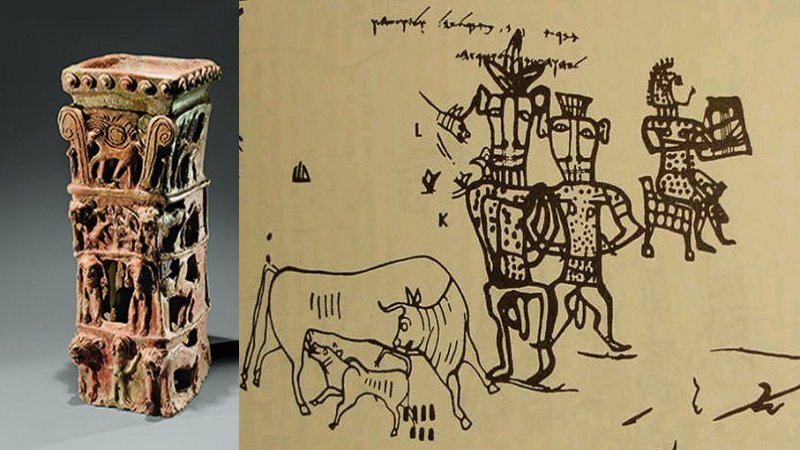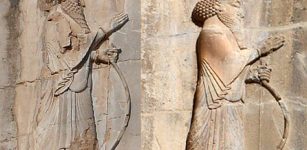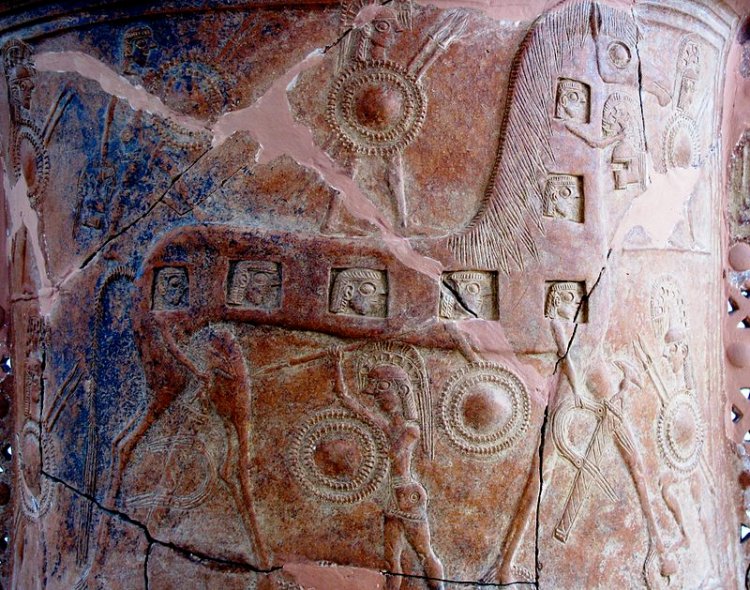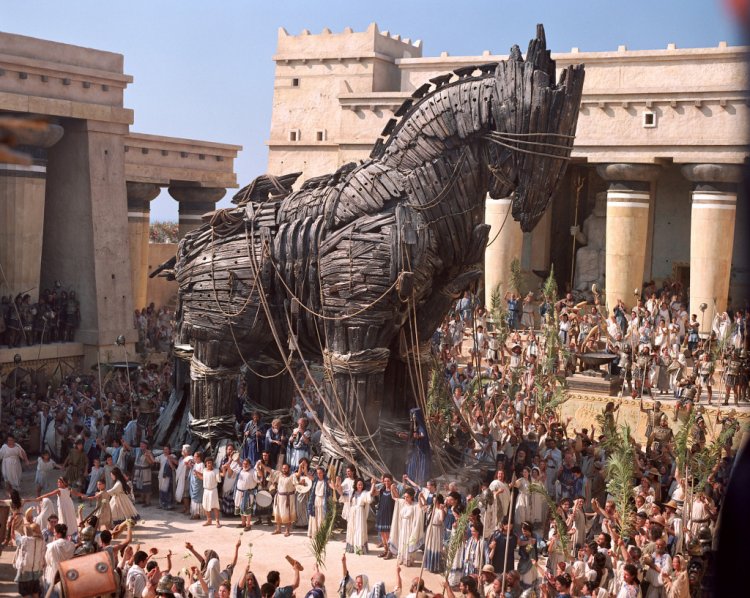Did The Ancient Trojan Horse Really Exist?
Ellen Lloyd – MessageToEagle.com – Our ancient human history is full of terrible wars. This is one of many wars that will never be forgotten. More than 3,000 years ago a horrible war broke out between the ancient Greeks and the Trojans. It lasted for 10 years and neither side seemed to be able to win this war.
The Greeks gathered the greatest army in the world and one thousand ships sailed to take the great city of Troy. For ten years, the best warriors waged fierce battle but in vain. Troy’s massive walls still stood protecting its citizens.
One day, Odysseus, the ruler of the island of Ithaca got a brilliant idea.
He ordered to build a big wooden horse on wheels, big enough to hide a bunch of Greek soldiers inside it.
A 19th-century painting of the Wooden Horse. A famous story tells how the Greeks captured Troy by hiding soldiers inside the giant horse.
The wooden horse was built. Acting like they had given up their long fight, most of the Greeks pretended to sail home.
Only one small group of soldiers stayed, hiding inside the horse.
The Trojans found the wooden horse but did not understand its presence.
Soon they also found a Greek soldier hiding nearby. He explained that his companions hated him and therefore they had left him behind.
When asked about the sudden presence of the strange wooden horse in the vicinity of the city, the Greek soldier said that it was an offering to the patron goddess, Athena.
No one in the city of Troy wanted to offend the goddess Athena, so they decided to drag the large horse into the city.
None of Troy’s gates was big enough to get it in, so they had to tear down a piece of the city wall to get the wooden statue inside.
Some of the ruins of ancient Troy, discovered in present-day Turkey. Image credit: National Chiao Tung University.
They left it at the temple of Athena and prepared a big party to celebrate their victory and the final end of a long war. In the meantime, the Greek soldiers were still sitting quietly inside the horse statue.
This was the last party in the Trojan lives. They allowed themselves to be totally fooled by the Greeks’ trick. It cost much.
The Mykonos vase, with one of the earliest known renditions of the Trojan Horse. (Note the depiction of the faces of hidden warriors shown on the horse’s side.) Image credit: Travelling Runes
At night, when the citizens of Troy had fallen asleep, the Greek soldiers came out of the Trojan Horse and killed the guards on the walls.
They opened the gates of Troy and gave the signal to the Greek hiding nearby to storm the city.
There was a big battle and the city was totally destroyed. The Trojans could not win this war; the Greeks did.
Is there any truth behind the myth of the Trojan horse?
The Trojan Horse is mentioned in the great poem “Aeneid” written by a classical Roman poet, Virgil, in 19 BC and in other ancient Greek sources. The event is referred to in Homer’s Odyssey. In the Greek tradition, the horse is called the “Wooden Horse”.
Pausanias, a Greek traveler, and geographer of the 2nd century AD, theorized that the Trojan horse was a gigantic battering ram whose form reminded of a horse.
Ancient Greek historians believed that the siege of Troy was probably between 1300 and 1100 BC, and it is known that the Assyrians at this time had the habit of naming their great siege machines after animals.
There has been speculation that the Trojan Horse may have been a battering ram slightly resembling a horse. The description of the use of this device was then transformed into a myth by later oral historians who were not present at the battle and were unaware of the meaning of the name. In those days it was common for Assyrians to use siege machines with animal names, often covered with dampened horse hides to protect against flaming arrows.
The Trojan Horse could have been one of such siege machines built by the Greeks in order to finalize their war plans.
Written by – Ellen Lloyd – MessageToEagle.com
Copyright © MessageToEagle.com. All rights reserved. This material may not be published, broadcast, rewritten or redistributed in whole or part without the express written permission of MessageToEagle.com
Related Posts
-
 Ancient Secrets Of The Ukrainian Stonehenge That Is Older Than The Giza Pyramids Of Egypt
No Comments | Jul 17, 2021
Ancient Secrets Of The Ukrainian Stonehenge That Is Older Than The Giza Pyramids Of Egypt
No Comments | Jul 17, 2021 -
 Disappearance Of The El Argar Civilization – Why Has No One Lived In The La Almoloya Region Again?
No Comments | May 23, 2022
Disappearance Of The El Argar Civilization – Why Has No One Lived In The La Almoloya Region Again?
No Comments | May 23, 2022 -
 Ancient ‘Yahweh And His Asherah’ Inscriptions At Kuntillet ‘Ajrud Remain An Unsolved Biblical Mystery
No Comments | Feb 13, 2021
Ancient ‘Yahweh And His Asherah’ Inscriptions At Kuntillet ‘Ajrud Remain An Unsolved Biblical Mystery
No Comments | Feb 13, 2021 -
 Mysterious Bronze Age Burial Chamber Discovered In Devon, UK
No Comments | May 23, 2024
Mysterious Bronze Age Burial Chamber Discovered In Devon, UK
No Comments | May 23, 2024 -
 Naqsh-e Rostam: Spectacular Tomb Complex With Rock Reliefs From Elamite To Sasanian Times
No Comments | Jun 15, 2016
Naqsh-e Rostam: Spectacular Tomb Complex With Rock Reliefs From Elamite To Sasanian Times
No Comments | Jun 15, 2016 -
 Mysterious Kola Pyramids Built By An Unknown Lost Ancient Civilization Can Rewrite Ancient History
No Comments | Aug 4, 2020
Mysterious Kola Pyramids Built By An Unknown Lost Ancient Civilization Can Rewrite Ancient History
No Comments | Aug 4, 2020 -
 10 Mysterious Ancient Manuscripts With Hidden Secrets
No Comments | May 27, 2016
10 Mysterious Ancient Manuscripts With Hidden Secrets
No Comments | May 27, 2016 -
 Mystery Of the Panxian Cave – How Could Gigantic Animals Reach A Mountain Cave Located Over 1600m Above Sea Level?
No Comments | Jul 1, 2014
Mystery Of the Panxian Cave – How Could Gigantic Animals Reach A Mountain Cave Located Over 1600m Above Sea Level?
No Comments | Jul 1, 2014 -
 Ancient Chinese Ingenuity Created Sophisticated Time Keeping Machines: Proof Of Remarkable Ancient Knowledge
No Comments | Jun 16, 2015
Ancient Chinese Ingenuity Created Sophisticated Time Keeping Machines: Proof Of Remarkable Ancient Knowledge
No Comments | Jun 16, 2015 -
 Ancient Mysteries Of West Virginia: Did Ancient Celts Visit North America Where They Left An Ogham Inscribed Bone Needle With Christian Symbols?
No Comments | Mar 1, 2017
Ancient Mysteries Of West Virginia: Did Ancient Celts Visit North America Where They Left An Ogham Inscribed Bone Needle With Christian Symbols?
No Comments | Mar 1, 2017




